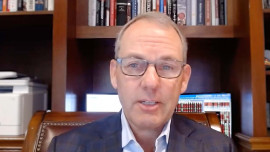Backdrop for Bond Investing Brighter in 2024
Could 2024 Finally be the Year of the Bond?
Why long duration and quality consumer-related securitized credit are attractive to Loomis Sayles’ Core Plus Bond team entering 2024.
Go long: In a lower growth, softer inflation environment, being long duration – especially in the Treasury market – may be more beneficial for fixed income investors.
Study the consumer for opportunity: Securitized credit that is consumer facing has been a good place to be during this time of US consumer resiliency.
Flexibility is key: As we transition from late expansion phase of the credit cycle to a period where growth may be slower, and where Fed policy is likely to be easier, the ability to actively allocate anywhere across various sectors of the fixed income markets, including high yield, bank loans or emerging markets, to take advantage of a dislocation can add value.
All investing involves risk, including the risk of loss. Investment risk exists with equity, fixed income, and alternative investments. There is no assurance that any investment will meet its performance objectives or that losses will be avoided. Investors should fully understand the risks associated with any investment prior to investing.
Fixed income securities may carry one or more of the following risks: credit, interest rate (as interest rates rise bond prices usually fall), inflation and liquidity.
Interest rate risk is a major risk to all bondholders. As rates rise, existing bonds that offer a lower rate of return decline in value because newly issued bonds that pay higher rates are more attractive to investors.
Duration risk measures a bond's price sensitivity to interest rate changes. Bond funds and individual bonds with a longer duration (a measure of the expected life of a security) tend to be more sensitive to changes in interest rates, usually making them more volatile than securities with shorter durations.
Plus sectors refer to additional fixed income sectors some strategies invest in such as high yield bonds, emerging market bonds, floating rate bank loans, and non-US dollar bonds, to seek greater diversification or yield potential.
Unlike passive investments, there are no indexes that an active investment attempts to track or replicate. Thus, the ability of an active investment to achieve its objectives will depend on the effectiveness of the investment manager.
CFA® and Chartered Financial Analyst® are registered trademarks owned by the CFA Institute.
6171395.1.1


 2024 Private Assets Report
2024 Private Assets Report
 Investment Outlook: Loomis Sayles
Investment Outlook: Loomis Sayles

